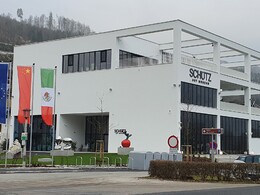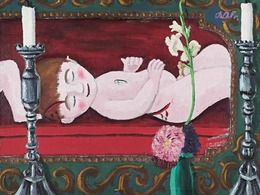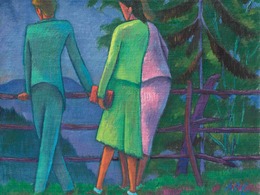New exhibition at the Schütz Art Museum




- All weather
- Suitable for groups
next event
Event location
Schütz Art MuseumNibelungenstraße 36
4090 Engelhartszell
Contact
Schütz Art MuseumNibelungenstraße 36, 4090 Engelhartszell
Phone+43 7717 20320
mobile+43 664 1308699
E-Mailoffice@schuetzartmuseum.at
Webwww.schuetzartsociety.at/museum
Werner Berg: Selected Works - Life and Death
Exhibition duration
09 February 2024 - 29 September 2024
A tribute to an outstanding artist whose work continues to inspire
When Werner Berg died in his studio at Rutarhof on 7 September 1981, he could look back on a long, full life and rich oeuvre as a painter, graphic artist and draughtsman. An essential feature of his life, which began on 11 April 1904 in Elberfeld (Wuppertal), was a life of seclusion and the negation of social norms and conventions. He did not want to conform or bend, neither artistically nor socially. Werner Berg lived for 30 years without electricity or gas and without running water, uncompromisingly sparse and archaic. His uncompromising attitude and clarity made him a difficult man. Today, Werner Berg would be labelled a dropout. In his ascetic turn to the barren, in his pronounced demands and his active return to nature, in his questioning of what is really necessary in life, in his reduction to the essential, the truthful, Werner Berg is more relevant today than ever.
The Schütz Art Museum is delighted to be able to offer an insight into the work of this extraordinary artist under the title "Werner Berg - Selected Works - Life and Death" from 9 February to 29 September. The Schütz Art Museum has been able to present Werner Berg's work internationally on several occasions. In 2013, we organised a comprehensive solo exhibition at the National Art Museum of China Beijing and the Shanghai Duolun Museum of Modern Art, which attracted 110,000 and 125,000 visitors respectively within ten days. This was followed in 2015 by the highly acclaimed "Austrian Art 1860-1960" exhibition in China, which was visited by almost 5 million people and in which Berg's work took pride of place alongside Gustav Klimt, Egon Schiele, Carl Moll, Willy Eisenschitz et alii. Finally, in 2020, we presented the retrospective "Werner Berg in Bavaria" at Neuburg Castle together with the Staatsgalerie Bayern. The Werner Berg Museum in Bleiburg regularly shows Berg's work in dialogue with other artists, and the exhibition "Werner Berg - Life as Art" can be seen at the Chabot Museum in Rotterdam until March 2024. The total value of the current exhibition at the Schütz Art Museum is remarkable, totalling more than 12,000,000 euros.
Werner Berg's oeuvre is characterised by four themes: Childhood, joie de vivre, illness and death. The stages of everyday life run like a common thread through Berg's work: Birth, school, work and death.
"Childhood" plays a role in many paintings, drawings, sketches and woodcuts. Children at play, in winter, in the snow, at the lake, on the mountain, alone or together with family members, sometimes in everyday life, but also in dying and in death. The melancholic depictions of children can be interpreted as a nostalgic look back at the loss of one's own childlike carefreeness. This ends abruptly with the experience of the First World War. The painting "Shrine of the Innocent Children" bears eloquent witness to this.
Werner Berg experienced the glamour of Berlin in the "golden twenties" as hell and an abyss. Consequently, he and his wife Amalie "Mauki" Kuster decided to move to the countryside and lead an archaic, honest, down-to-earth "wild marriage" in the seclusion of the Rutarhof. Joy, lust, eroticism and pleasure were part of his personality despite the ascetic, Catholic principles according to which Berg also organised his life. In what he called his "circuit of the Catholic", love triangles and affairs nevertheless took place. In Berg's work, this is expressed by three people who are attracted to each other, usually a man and two women, as a frequently recurring motif. Roast pork, pig's heads, richly laid tables and indulgence bear witness to the artist's inner contradictions between asceticism and debauchery.
Berg visualises the originality of rural life and the natural way of life in the landscape and among the population of the Slovenian-Austrian border region in oil paintings and woodcuts, which bring the viewer directly into the proximity of the pictorial motif. Werner Berg chooses the art form of the woodcut. He interprets the barren, archaic black and white as "intensification, concentration and summarisation" in order to convey the "reality of our days" to the viewer. Sobriety and coldness dominate in the depictions of the landscape and his own family at this time.
In his late work, Werner Berg thematically focussed on suffering, illness and death. As a result of Werner Berg's wartime experiences and the strokes of fate that befell his immediate surroundings, illness and death played an increasingly important role in his life and work. The sick, the wounded, the deceased and similar motifs are combined with religious motifs. Catholicism and religious spirituality are a source of comfort for Werner Berg, but he also perceives religion as a contradiction. Werner Berg is portrayed in the exhibition as an artist caught between two worlds. The selection of pictures reflects his examination of the duality of human life
- Beauty of life against the transience of man
- Pleasure and joy of life against asceticism
- Light of human existence and shells of human transience
- Life against illness and death
Werner Berg's works on display invite the viewer to engage with the profound questions about the meaning of life and the inevitability of death. The Schütz Art Museum opens its doors for an artistic journey through the life and work of Werner Berg that will resonate with visitors for a long time to come.
09 FEBRUARY 2024 - 29 SEPTEMBER 2024. SEPTEMBER 2024
Open daily Tue-Sat, 10:00-18:00
Nibelungenstraße 36, A-4090 Engelhartszell
The exhibition is accompanied by the publication "WERNER BERG, AUSGEWÄHLTE WERKE - LEBEN UND TOD" SCHÜTZ ART MUSEUM
Mail: office@schuetzartmuseum.atWeb: www.schuetzartmuseum.at
© Schütz Art Museum, Engelhartszell, 2024
Nibelungenstraße 36, 4090 Engelhartszell
Phone+43 7717 20320
E-Mailoffice@schuetzartmuseum.at
Webhttps://www.schuetzartsociety.at/museum
- Toilet facility
- All weather
- Suitable for groups
- Suitable for schools
- Suitable for seniors
- Suitable for single travelers
- Suitable for friends
Completely suitable for wheelchairs. The object complies with the legally stipulated ÖNORM.
- Toilet facility for disabled people
next event
Event location
Schütz Art MuseumNibelungenstraße 36
4090 Engelhartszell
Contact
Schütz Art MuseumNibelungenstraße 36, 4090 Engelhartszell
Phone+43 7717 20320
mobile+43 664 1308699
E-Mailoffice@schuetzartmuseum.at
Webwww.schuetzartsociety.at/museum
Suggest changes
Please let us know how we can improve the quality of this object or if there is any incorrect information on this page (eg. opening hours, contact, etc.).
Please fill in all fields marked *.






